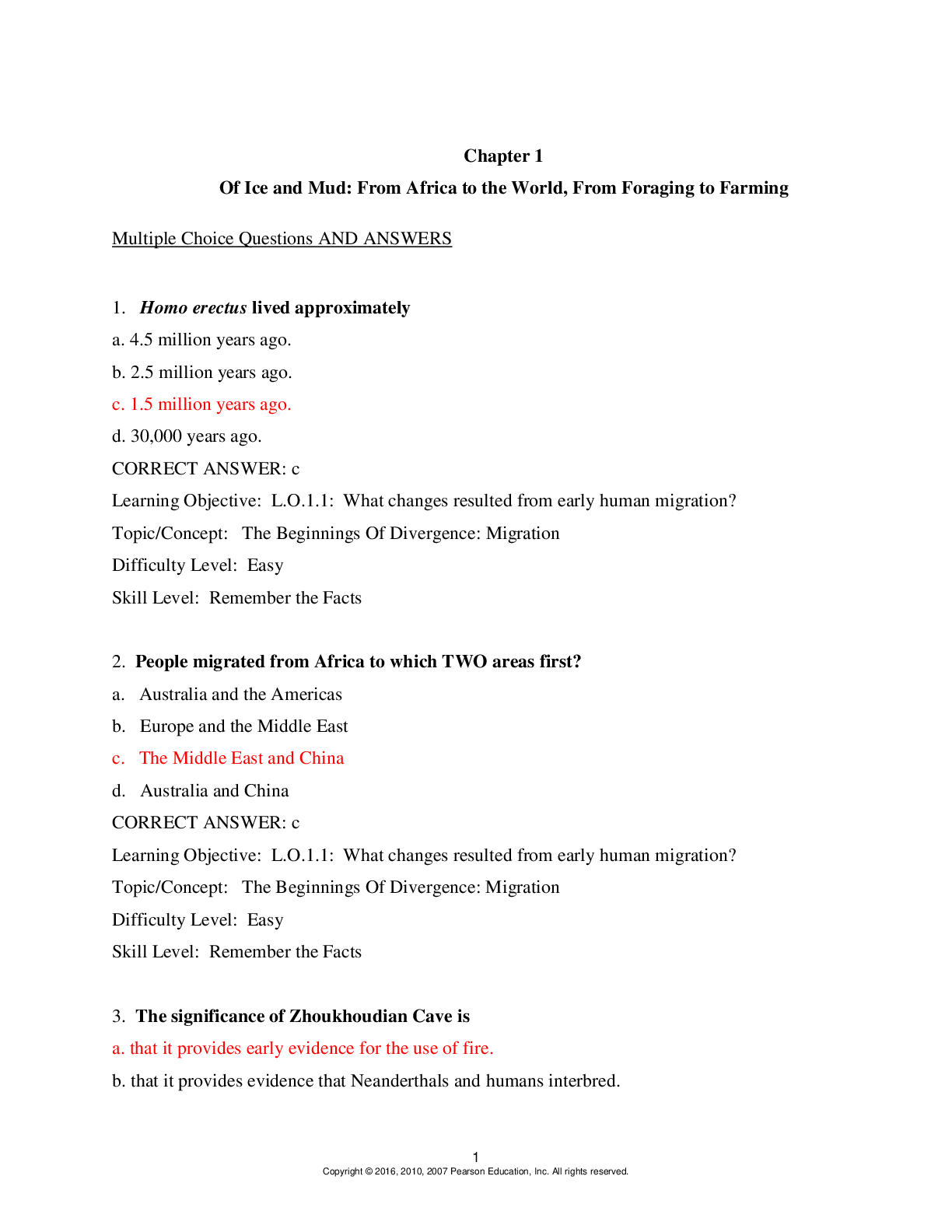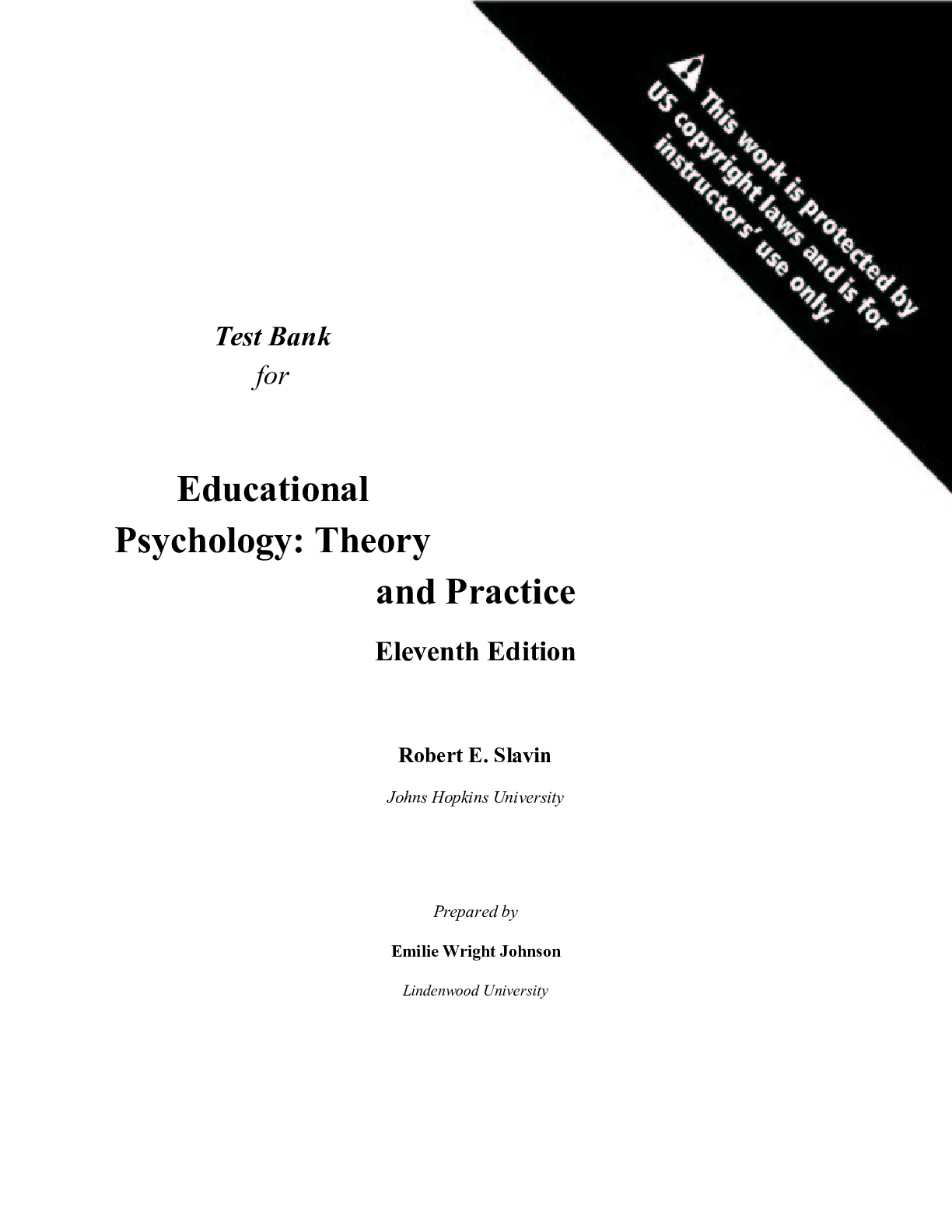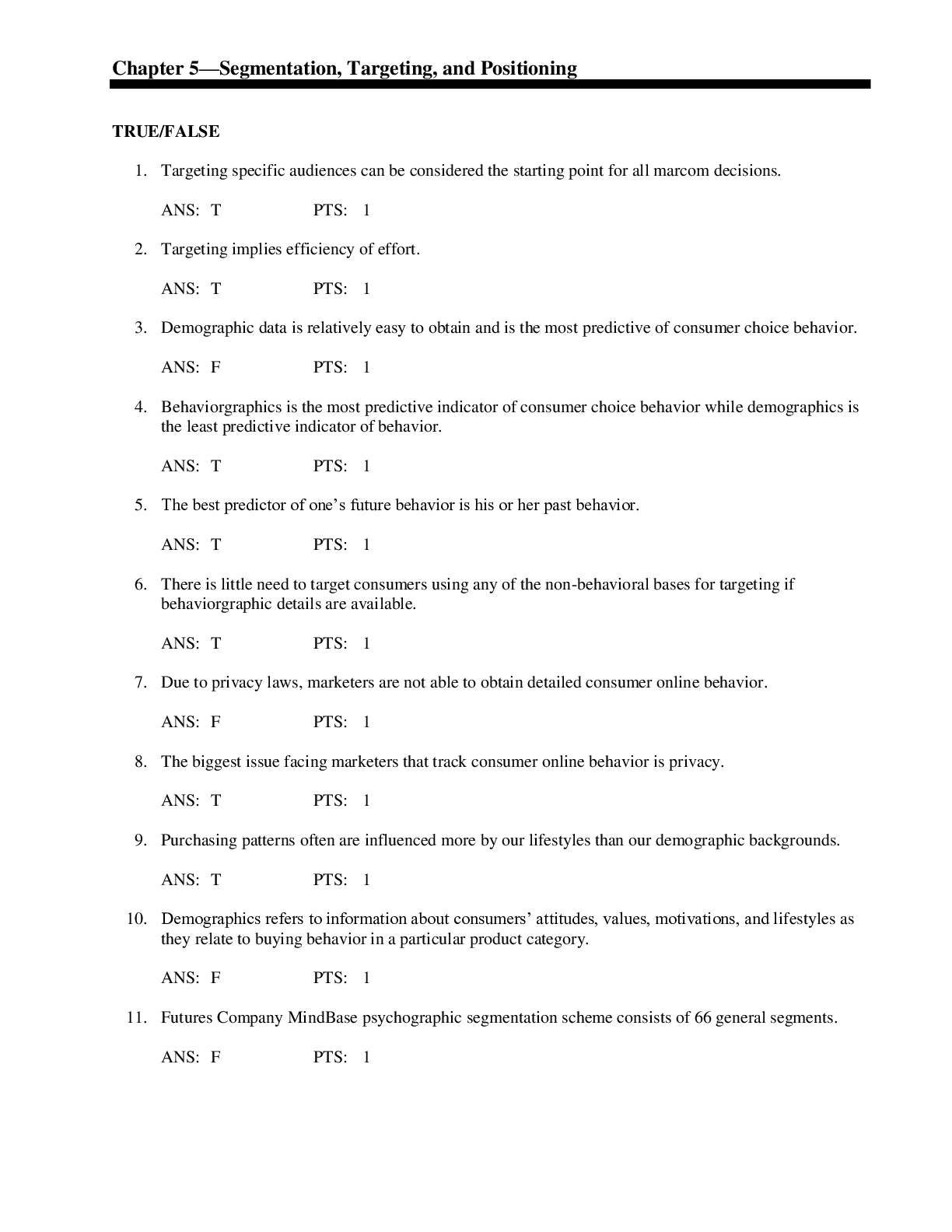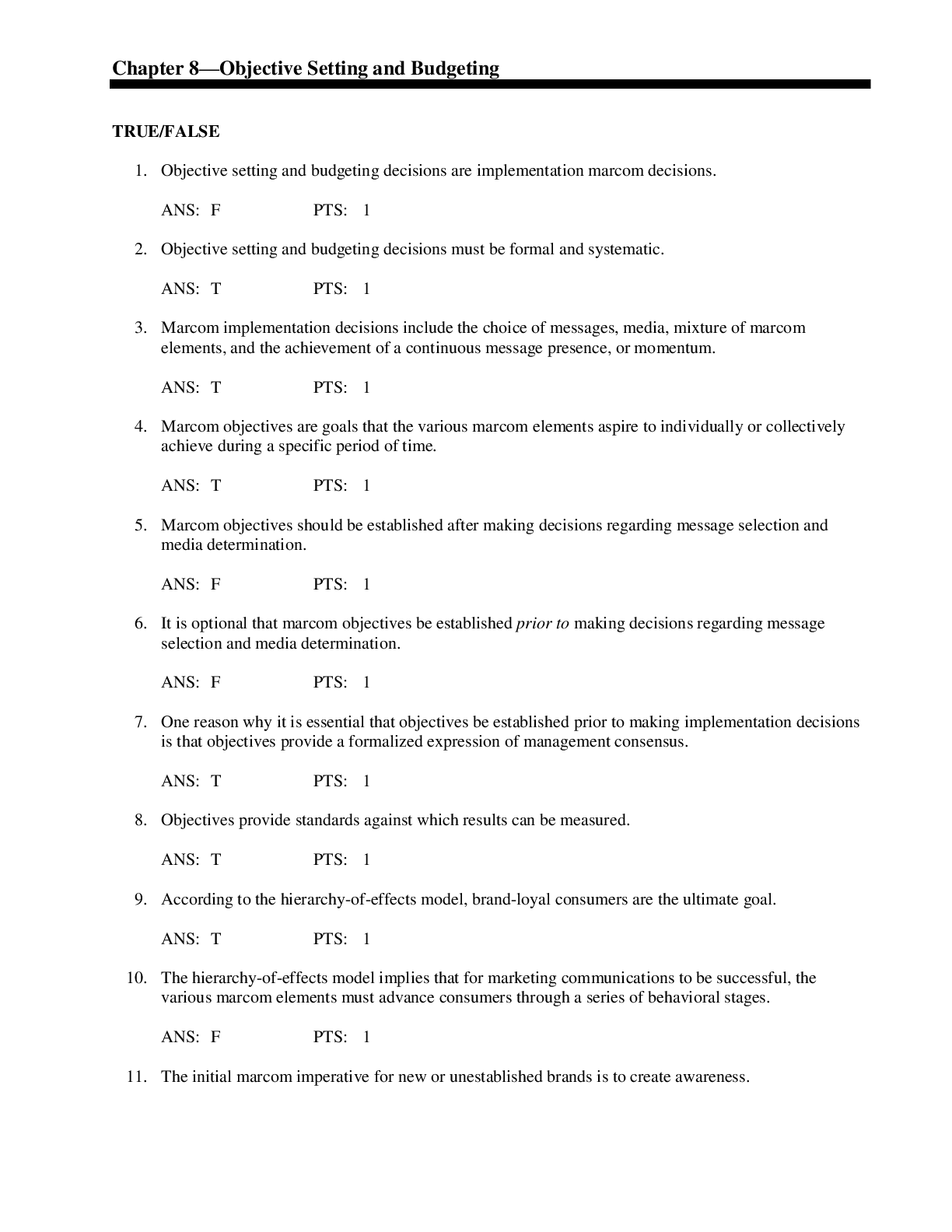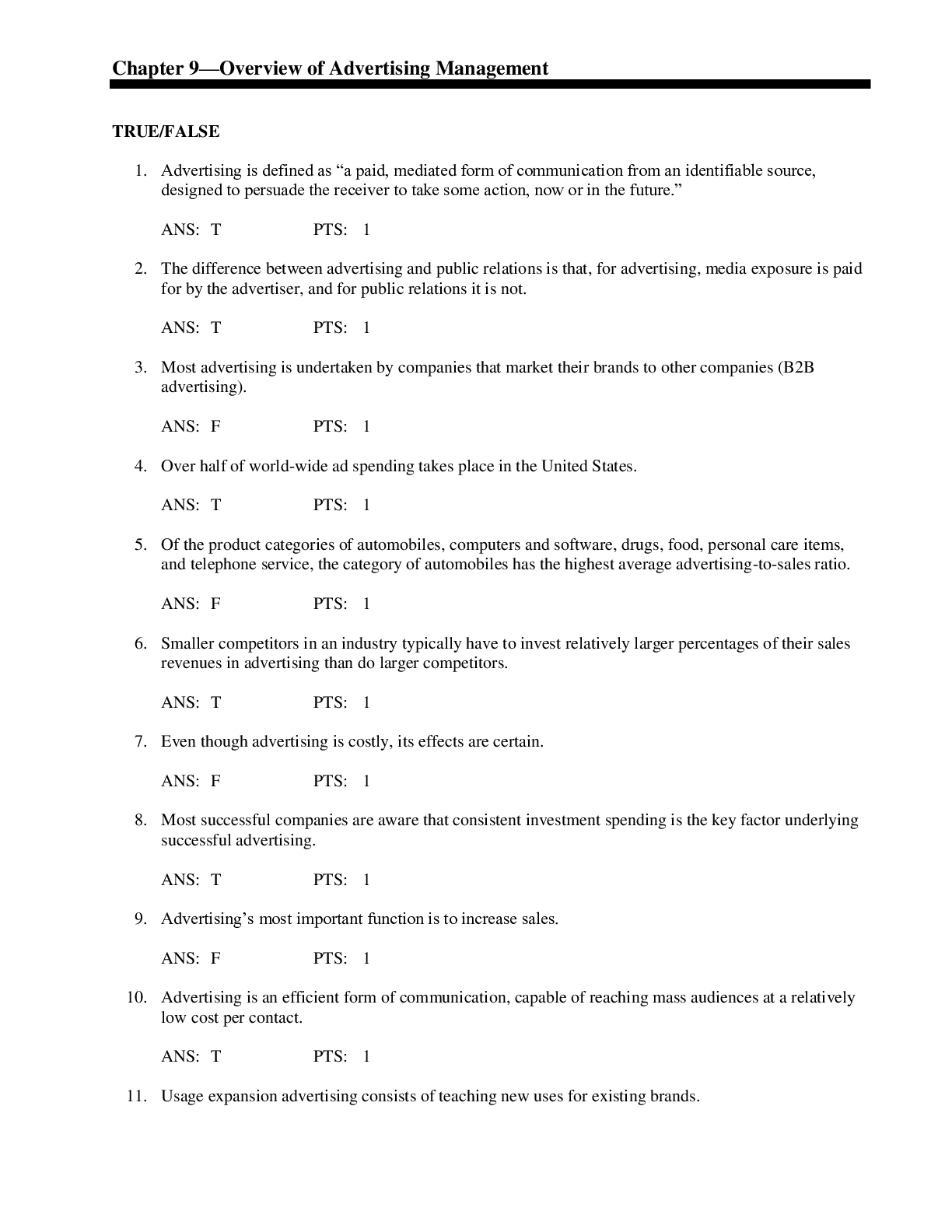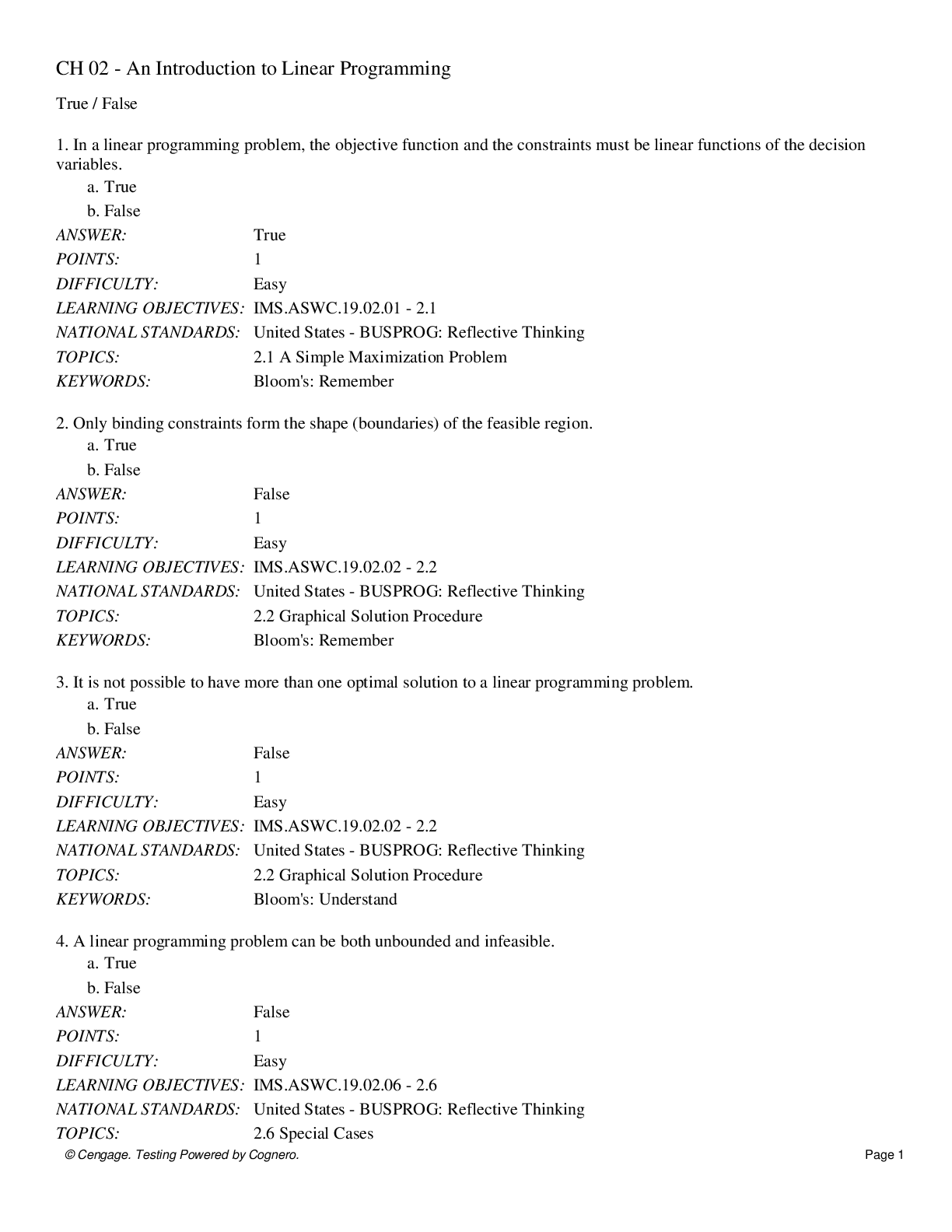Education > QUESTIONS & ANSWERS > Foundations of reading practice test questions and answers 100% pass (All)
Foundations of reading practice test questions and answers 100% pass
Document Content and Description Below
Foundations of reading practice test questions and answers 100% pass Comprehension ✔✔This Occurs when the reader correctly interprets the print on the page and constructs meaning from it. It de... pends on activating prior knowledge, cultural and social background of the reader, and the readers ability to use comprehension strategies. Phonological Awareness ✔✔the awareness that oral language is composed of smaller units, such as spoken words and syllables Phonemic awareness ✔✔a specific type of phonological awareness involving the ability to distinguish the separate phonemes in a spoken word. Rhyming ✔✔ Segmenting ✔✔Breaking words down into sounds. The process of hearing a spoken word and identifying it's separate phonemes or syllables. Blending ✔✔The process of hearing separate phonemes and being able to merge them together to read a word. Deletion ✔✔the removal of sound from a word. It requires manipulation of phonemes in words and is considered to be more difficult than other forms of phonemic awareness. EX: remove B from Back you get ack, or remove t from true you get rue. etc. Substituting ✔✔ Onsets ✔✔part of the syllable that precedes the vowel of the syllable. EX:("spl" in split) rimes ✔✔A rime is the part of a syllable which consists of its vowel and any consonant sounds that come after it. EX: ("it" in split) Syllables ✔✔a unit of pronunciation having one vowel sound, with or without surrounding consonants, forming the whole or a part of a word; e.g., there are two syllables in water and three in inferno. Explicit Strategies ✔✔Explicit instruction involves direct explanation. Concepts are clearly explained and skills are clearly modeled, without vagueness or ambiguity Implicit Strategies ✔✔implicit phonics, also referred to as analytical phonics, moves from the whole to the smallest part. Phonemes associated with particular graphemes are not pronounced in isolation. Students analyze words and look for the common phoneme in a set of words. Through comparison and identification, they deduce which grapheme to write or which phoneme to read. Blending and building are not usually taught, and students identify new words by their shape, beginning and ending letters, and context clues. This analysis (breaking down) of the whole word to its parts is necessary only when a child cannot read it as a whole word. This is a wholelanguage approach. Hearing rhymes (rime) ✔✔ Hearing Alliteration (onset) ✔✔ Hearing assonance (vowel/vowel combination sounds) ✔✔ Hearing the non-matching sound or word ✔✔ Hearing and blending syllables in words ✔✔ Splitting syllables and oral blending (onset-rime-whole word) ✔✔ Analyzing words into syllables and sounds (segmenting) ✔✔ Manipulating sounds in words (substitutions and deletions) ✔✔ Distinguishing spoken words syllable, onset, phonemes (phonemic awareness) ✔✔ Connecting sounds and letters for spelling ✔✔ Environmental print ✔✔ Alphabet principle ✔✔The recognition that phonemes are represented by letters and letter pairs. Book handling skills ✔✔ Promoting letter knowledge ✔✔ Modeling ✔✔ Letter knowledge ✔✔skill in recognizing upper-case and lower-case letters Phoneme ✔✔The speech sound units that make a difference in meaning. The word "rope "has three phonemes /R/,/0/, and/P/. Change one phoneme, say/R/ to/n/, And you have a different word "nope. " morpheme ✔✔The smallest unit of grammar in the English language. In other words, it is the smallest unit of meaning, not just sounds. consonant digraph ✔✔Two consonants of the English language who when placed together in a word make a unique sound, neither makes when alone. Examples: CH, TH, SH, and WH. consonant blend ✔✔When two consonants are put together, but each retain their individual sound. The two sounds go together in a seamless manner to produce a blended sound. Examples: ST, BR, CL, ET see. decoding ✔✔"Sounding out "a printed sequence of letters based on knowledge of letter sound correspondences. encoding ✔✔To change a message into symbols. For example, readers and code oral language into writing. semantic cues ✔✔Children use their prior knowledge, sense of story, and pictures to support they're predicting and confirming the meaning of the text. syntactic cues ✔✔Use the order of words and the student's knowledge of the oral English language to help determine if what is read could be accurate. Prefix ✔✔ Suffix ✔✔ Morpheme ✔✔The smallest units of meaning in words. There are two types of morphine's; free morphemes, which can standalone such as love, and found more themes, which must be attached to another morphine to carry meaning such as Ed in loved. Grapheme ✔✔ Base word ✔✔ Homographs ✔✔ Context cues ✔✔ Common Morpheme ✔✔base words, rots, inflections, other affixes Common Prefixes ✔✔En, Re, Pre Common Suffixes ✔✔tion, able Oral language ✔✔ Proverbs ✔✔ Idioms ✔✔A phrase whose the literal meaning differs from its figurative meaning. Example: raining cats and dogs, see the light. Word bank ✔✔ Direct teaching ✔✔ Awareness of words ✔✔ Use of Dictionary ✔✔ Word maps for learning unfamiliar words ✔✔ Focus on key words in content-area vocabulary ✔✔ Semantic and syntactic cues ✔✔ Read-alouds ✔✔ Word explanation strategies ✔✔ Fluency ✔✔ figurative language ✔✔ Literal ✔✔ Inferential ✔✔ Evaluative ✔✔ Creation of story maps and graphic organizers ✔✔ Analyzing story elements ✔✔ Analyzing character development ✔✔ Interpreting figurative language ✔✔ Identifying literary allusions ✔✔ Analyzing the authors point of view ✔✔ Features of different literary genres ✔✔ Connecting elements in text to prior knowledge ✔✔ Predicting ✔✔ visualizing ✔✔ reviewing ✔✔ self-monitoring ✔✔ Retelling ✔✔ Adjusting reading rate based on text difficulty ✔✔ Self questioning ✔✔ paraphrasing ✔✔ oral preview/review ✔✔ student generated questions ✔✔ Note taking ✔✔ outlining ✔✔ Summarizing ✔✔ Semantic maps ✔✔ K-W-L charts ✔✔ Chronological structures ✔✔ Comparison/contrast ✔✔ Cause/effect ✔✔ Validity ✔✔ Bias ✔✔Occurs in testing when the information required to respond to a prompt assumes prior knowledge that the test taker may not have because of cultural, ethnic, linguistic or socioeconomic background. Reliability ✔✔The consistency of a test. This is measured by whether the test will indicate the same score for the child who takes it more than once. Text Leveling ✔✔ Assessment of phonemic awareness ✔✔ Miscue analysis ✔✔Can be used to asses a student's reading development through running records or informal reading inventory. Informal reading inventories ✔✔A series of graded passages used to determine students' levels of reading and strengths and needs in decoding and comprehension. Running records ✔✔A written record of a student's oral reading in which a blank sheet of paper rather than a copy of the actual text is used in the coding. Example: a first grade teacher has a student read aloud a previously read book, noting the correct and incorrect words. rubrics ✔✔A set of guidelines or acceptable responses for the completion of the task. Example: a rubric for assessing the writing quality of a story would include being able to identify the story element (setting, Characters, problem, action, outcome) and a four point scale in which four is high, three is average, two is low, one is inadequate, and zero indicates insufficient material. Portfolio assessment of authentic tasks ✔✔ Oral or Written retellings (to assess reading comprehension) ✔✔ Dictated word lists (to test letter-sound knowledge) ✔✔ Challenges and supports in texts: pictures, predictability, decoding ✔✔ Miscue ✔✔An oral reading response that differs from the text. Schwa sound ✔✔A vowel sound which is neutral. It typically occurs in the unaccented syllables of a word. An example would be the sound of the a at the end of the word "sofa" it is represented in print by an upside down e. Orthography ✔✔a method of representing spoken language through letters and diacritics. dipthong ✔✔two vowel sounds "sliding" into each other as in Loud (the ah-oosound) and right (the I-EE sound) Phonological awareness continuum ✔✔ [Show More]
Last updated: 1 year ago
Preview 1 out of 15 pages
Instant download

Buy this document to get the full access instantly
Instant Download Access after purchase
Add to cartInstant download
Also available in bundle (1)

Foundations of Reading Bundled Exams Questions and Answers Already Passed
Foundations of Reading Bundled Exams Questions and Answers Already Passed
By Nutmegs 1 year ago
$24.5
18
Reviews( 0 )
Document information
Connected school, study & course
About the document
Uploaded On
Apr 18, 2023
Number of pages
15
Written in
Additional information
This document has been written for:
Uploaded
Apr 18, 2023
Downloads
0
Views
63

.png)
.png)
.png)
.png)
.png)
.png)
.png)
.png)
.png)
.png)
.png)


